Taiwan High Speed Rail
The Taiwan High-Speed Rail (abbreviated THSR) is a high-speed rail network
that runs along the west
coast of Taiwan. It is approximately 339.3 kilometers long, and runs
from Taipei City to Kaohsiung City.
THSR began operation in January 2007. The THSR is based on Japan's Shinkansen
system, and its
Taiwan High Speed 700T train is a variant of the 700 Series Shinkansen.
The 700T train is built by
Kawasaki Heavy Industries. The total cost of the project is estimated to
be US$15 billion. This is one
of the largest privately funded transport schemes to date. An express train
capable of running at up
to 300 kms/h would travel from Taipei City to Kaohsiung City in 96
minutes, comparing to 284 minutes
on a train in the conventional western trunk line of Taiwan Railway, although
a local THSR train would
take 120 minutes to travel across the almost same route.
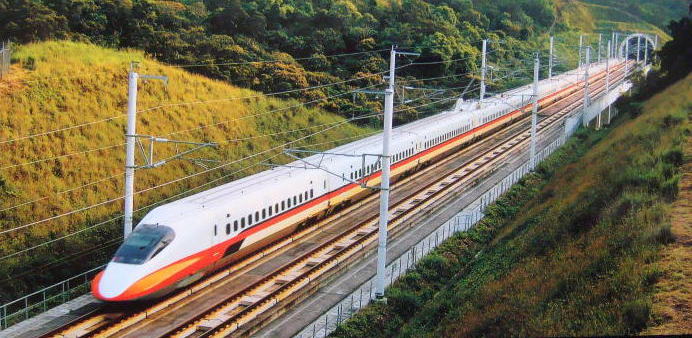
台湾高速鐵路
日本の新幹線技術が初めて輸出された台湾高速鐵路(THSR)は2007年3月に全線開業となった。在来線の
台湾鉄道を「台鐵」と略し、新しく出来た高速鉄道は「高鐵」との略語で表示されている。台北、左営間の
総延長は339.3kmの台湾を縦貫して走る鉄道である。始発から終点までの所要時間は各駅停車の列車で120分、
途中板橋と台中のみに停車する列車で96分である。車両は東海道・山陽新幹線の700系をベースとした
700T型で、最高速度は300km/h、列車は12両編成で、1号車から8号車が指定席、9号車から12号車が
自由席、6号車が商務車(ビジネスクラス)である。
台湾高速鐵路の車幅は日本のフル規格新幹線と同様、3,380mmである。列車は全て700T型で運転されている。
丘陵地帯を駆け上る性能は新幹線よりも優れている。製造は川崎重工、日本車両、日立の3社で、先頭車の
ノーズは台湾高速鐵路のトンネル断面積が日本の新幹線よりも大きい欧州規格で建設されたため700系よりも
350mm短い。2006年にグッドデザイン賞を受賞している。普通車は東側が2列、西側が3列シートの配列で、
商務車は2シート+2シートの列配置となっている。
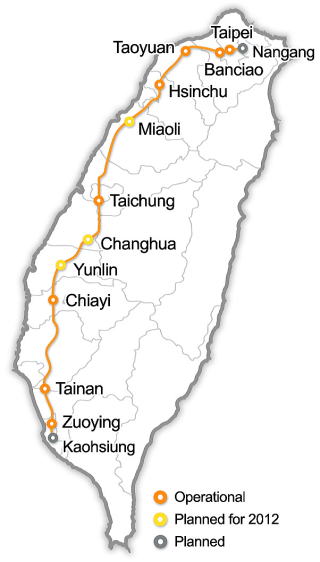 
(L) A route map of the Taiwan high speed train railways (THSR)
(R) The back side of the electronic THSR ticket should be up when inserting
it into a ticket gate.
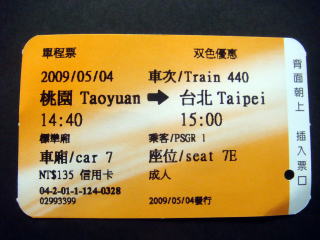 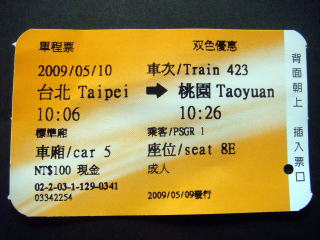
The THSR ticket ( Taoyuan to Taipei ) ( Taipei to Taoyuan ).

The THSR automatic ticket vending machines. It shows a discount on the
days' Monday through Thursday.
乗車券は磁気式で、上に示したものは指定席の切符である。切符の裏面に磁気が付いており、自動改札機では
磁気面を表にして矢印の向きに入れないとエラーが発生し、ゲートを通過出来ない。台北のような大きな駅では
常に係の人がいるので直ぐ対処してもらえる。「高鐵」、「台鐵」共に乗車券は現金のほか、クレジットカード
やキャッシュカードでも購入できる。65歳以上の高齢者の運賃は半額であるが、購入にはパスポートの提示が
必要である。
高鐵桃園(タオゥエン)駅は桃園国際空港がタクシーで15分の位置にある。全面ガラス張りで近代的な明るい
イメージを持つ駅舎である。駅のホーム(台湾では月台と表示)は地下にある。台鐵にも同名の駅があるが、
両駅は全く別の場所にある。
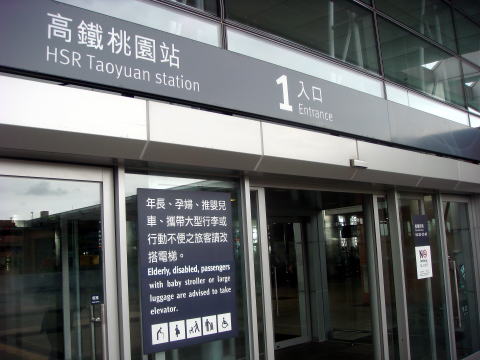 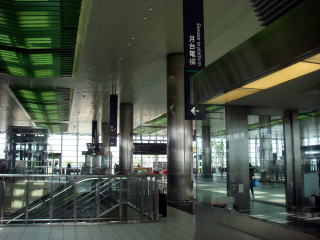
The entrance and interior of the THSR Taoyuan Station
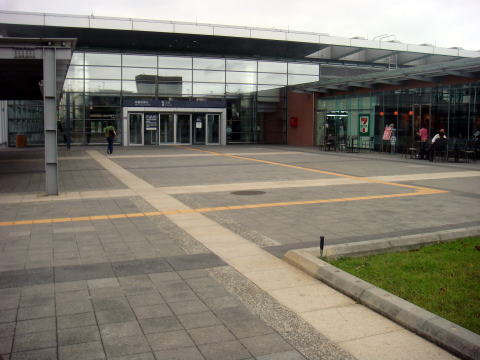 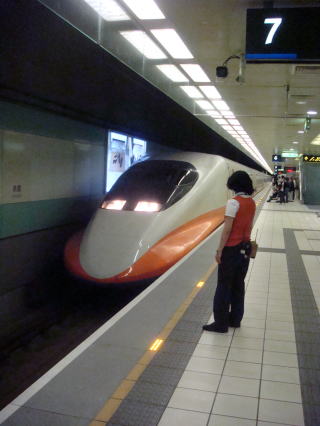
(L) The front view of THSR Taoyuan Station (R) An express train is now
arriving in the Taoyuan Station.
列車が近づくと黄色い線に埋め込まれたLEDが点滅する。また、列車が停車中でも、黄色い線を少しでも越える
とホーム監視員に笛を吹かれる。商務席(ビジネスクラス)の車両は6号車であるが、外観からは全く見分けが
つかない。車内の紫色の広いシートを見て、それと分かる。商務席ではコヒー、紅茶とスナックなどの無料
サービスがある。
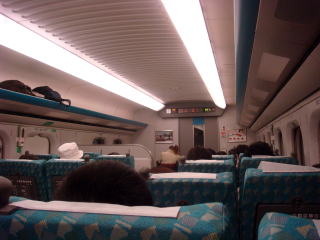 
(L) A standard class Seat of the high speed train.
(R) A business class train ( The train #6 ) and a train information plate.
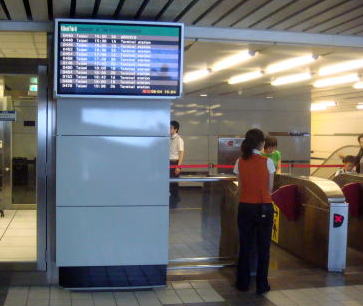 
(L) A ticket gate of the THSR Taipei Station (R) Taiwan Railway Taipei
Main Station
台湾高鐵の起点駅である台北(タイペイ)駅の駅舎は台鐵と共用しており、1989年に建てられたものである。
ホームは高鐵・台鐵ともに地下2階に位置する。高鐵のホームは元台鐵のホームを譲り受け、改装したもので、
2面4線を有している。英語名は「Taipei Main Station」である。
左営(ツォイン)駅は台湾高速鐵路の路線の最南端に位置する。左営駅の駅舎は地上4階建てで、コンコースは
2階、ホームは1階に位置する。海洋都市である高雄を象徴した波を描いた屋根を通じ明るい光が差し込んでくる。
隣に高鐵左営駅の完成に合わせて台鐵の「新左営」(シンツォイン)駅が新設されている。高鐵は将来、
市内の高雄駅まで延伸される計画がある。
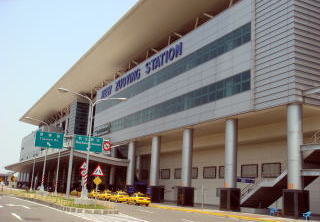 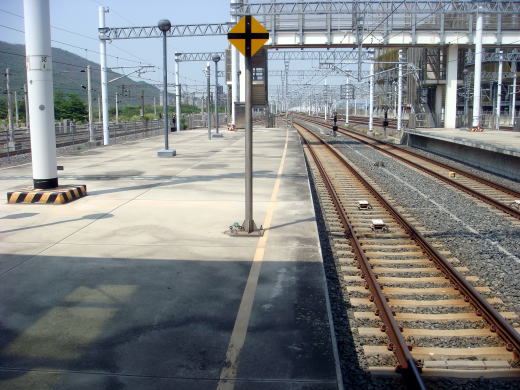
(L) The exterior of TSHR Zuoying station. 高鐵左営駅
(R) The south terminal station, Zuoying station.The railway tracks of THSR
extend to the northern part of Taiwan.
 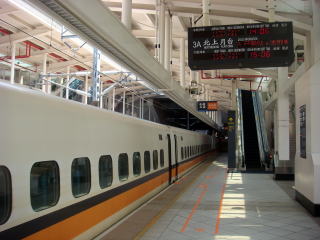
(L) The station hall and ticket gates of Zuoying station.
(R) A high speed train for Taipei is on the platform of Zuoying station.
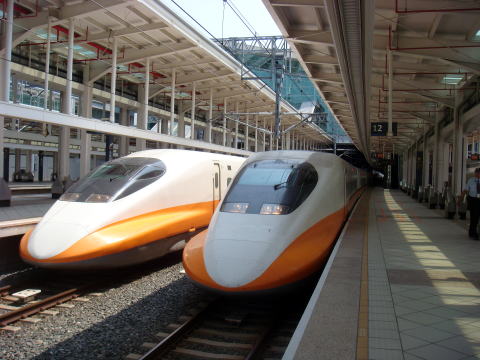 
(L) High speed trains for Taipei are waiting for a departure.
(R) A woman conductor at the entrance of a business class train on the
plateform of Zuoying station.
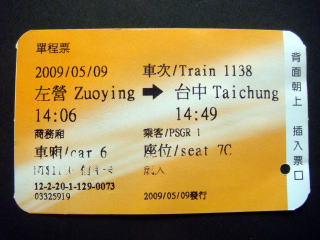 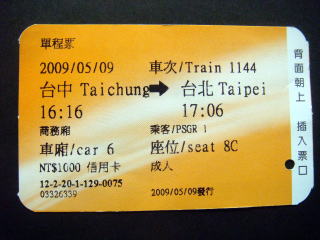
The THSR ticket ( Zuoying to Taichung ) ( Taichung to Taipei ).
 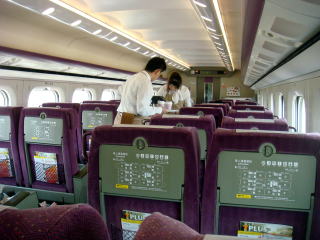
(L) An automatic fare adjustment machine at the THSR Zuoying station
(R) Free Tea Service at a Business Class Seat
台中(タイチョン)駅は台湾中部の中枢都市である台中の玄関口であり、高鐵の中間駅では最大規模の駅で
ある。ホームは地上3階に位置する。駅は台中市内のビジネス地区とはかけ離れており、市中から高鐵駅に
向かうときは、高鐵駅と交差する台鐵の「新烏日」(シンウーリー)駅までの電車を利用する。
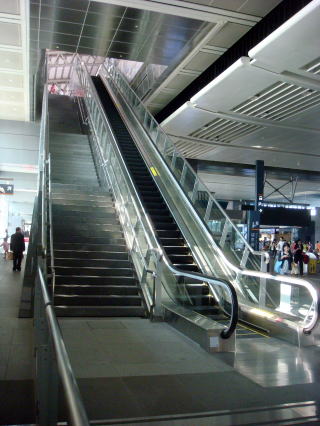 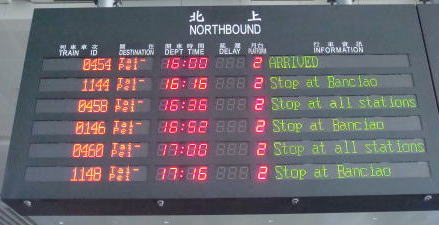
(L) An escalator in the THSR Taichung station. (R) A departure information
board at the THSR Taichung station.
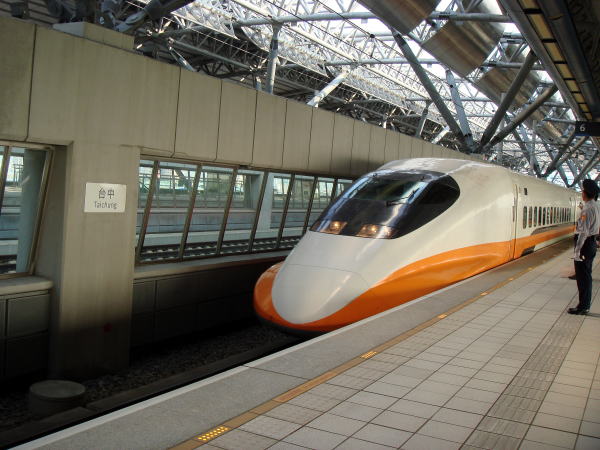
The THSR train for Taipei entering into the plateform of Taichung Station
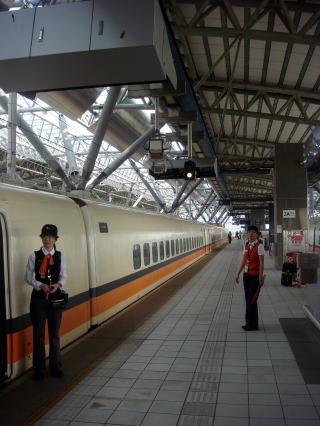 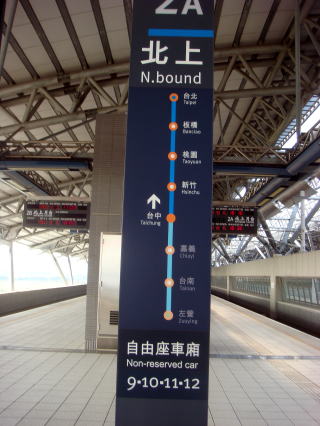
(L) A high speed train for Taipei at the platform of Taichung station.
(R) An information board of a non-reserved car at the THSR Taichung Station
700T型は日本の新幹線のような車掌用窓がないため、車掌は商務席車両の出入口で停車時のドアの開閉操作を行う。
また車両の停車中と出発直後の安全確認も同じ客用出入口で行う。そのため、他の客用扉が閉まった後も車掌の
使用する客用扉は開いている。
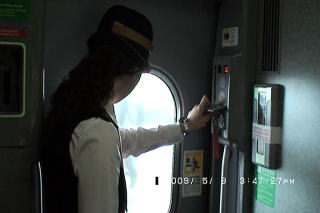 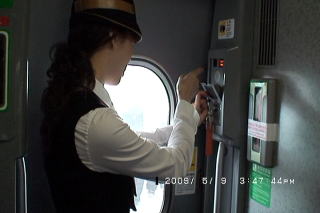 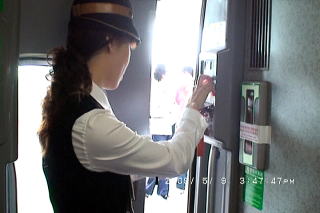
A woman conductor operating the switching signal of the train door open-and-shut
system.
ドアの開閉操作する女性乗務員
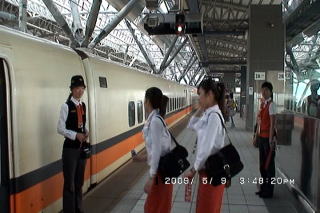  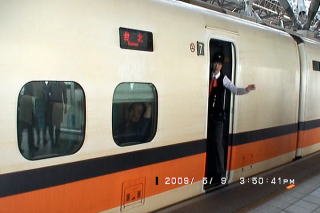
A woman conductor carefully checking the status of train doors at the Taichung
station.
女性乗務員が念入りに安全性を確認
 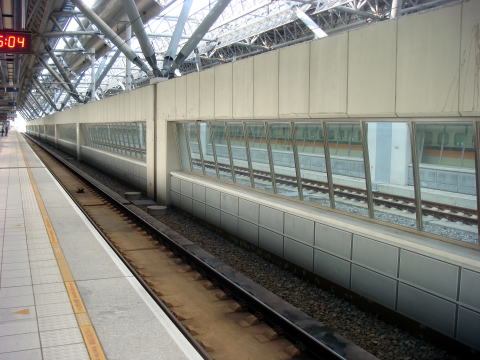
(L) The train crews after finish working are on the way home.
(R) A side track to pass through the THSR Taichung station.n a train. At
present, the side tracks are not in use.
台湾高速鐵道台中駅コンコースは解放的なガラス張りとなっている。通過追い越しのための上下2線が敷設されている
が、現在は台中駅を通過する列車はなく、使用していないので鉄路の路盤は真新しく見える。将来のノンストップ高速
運転を想定しての設計だろう。
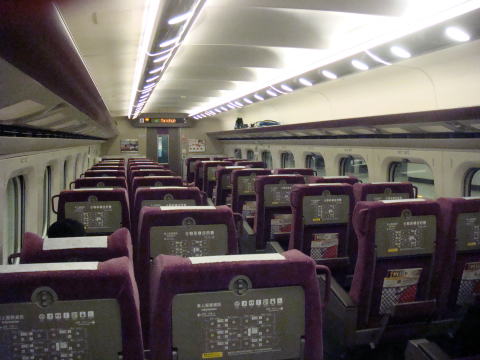 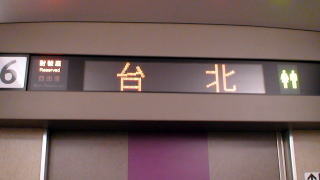
(L) THSR Train Business Class Seats (R) An electronic sign board informing
the arriving Taipei.
走行中の車内放送は軽やかなメロディーを流した後、先ず中国語で、次に英語で行う。車両前方の電光掲示板も中国語
と英語との二本立てである。2009年4月のダイヤ改正後、板橋駅と台中駅のみ停車する最速達列車は、台北・高雄間に
1日18本ほど運転されている。金曜、土曜、日曜(台湾では金曜を五、土曜を六の日と表記する)には、さらに10本
ほどの列車が増発される。当然のことながら列車内に喫煙できる施設はない。
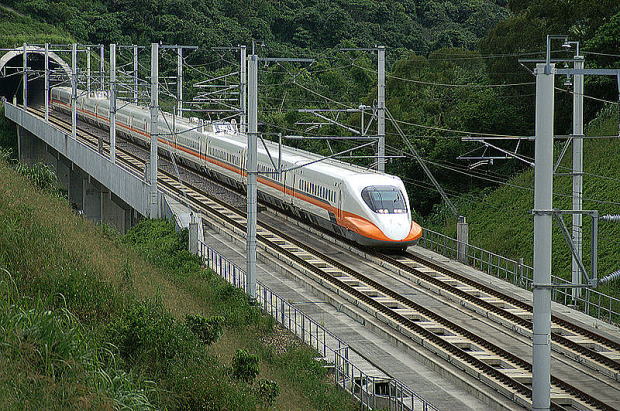
Taiwan High Speed Rail trial run in June 2006 ( From Wikimedia Commons )
 Taiwan High Speed Rail ( In Japanese ) Taiwan High Speed Rail ( In Japanese )
Travel by Train
All railway trains should be completely smoke -free.
 イタリア鉄道旅行記 Italia Rail: Trenitalia イタリア鉄道旅行記 Italia Rail: Trenitalia
 アイルランド鉄道旅行記 Rail Travel Ireland アイルランド鉄道旅行記 Rail Travel Ireland
 ニュージランド鉄道旅行記 NZ Rail: Tranz Alpine/Scenic ニュージランド鉄道旅行記 NZ Rail: Tranz Alpine/Scenic
 オーストラリア鉄道旅行記 Brief Journey by Australian Rail オーストラリア鉄道旅行記 Brief Journey by Australian Rail
 ボストン-ニューヨーク高速鉄道 Amtrak Acela Express/Boston_Newyork ボストン-ニューヨーク高速鉄道 Amtrak Acela Express/Boston_Newyork
 シカゴCTA鉄道 Chicago CTA Rail シカゴCTA鉄道 Chicago CTA Rail
 マイアミMETRO鉄道 Miami Metro Rail マイアミMETRO鉄道 Miami Metro Rail
 ワシントンDC地下鉄・ユニオン駅 Washington DC Metro/Union Station ワシントンDC地下鉄・ユニオン駅 Washington DC Metro/Union Station
 ストックホルム・アーランダ急行 Stockholm Arlanda Airport and Express ストックホルム・アーランダ急行 Stockholm Arlanda Airport and Express
 ストックホルム地下鉄・近郊鉄道 Stockholm County Railways ストックホルム地下鉄・近郊鉄道 Stockholm County Railways
 X2000の旅 X2000:Stockholm_Copenhagen Express X2000の旅 X2000:Stockholm_Copenhagen Express
 コペンハーゲン地下鉄・近郊鉄道 Greater Copenhagen Railways コペンハーゲン地下鉄・近郊鉄道 Greater Copenhagen Railways
 フィンランド鉄道、路面電車、地下鉄 Railways in Helsinki, Finland フィンランド鉄道、路面電車、地下鉄 Railways in Helsinki, Finland
 スイス・オーストリア・ドイツ鉄道 EU Trains 2013 スイス・オーストリア・ドイツ鉄道 EU Trains 2013
 バンコク・スカイトレイン・地下鉄・タイ鉄道 Bangkok Mass Transit/Thai Railways バンコク・スカイトレイン・地下鉄・タイ鉄道 Bangkok Mass Transit/Thai Railways
 台湾高速鉄道 Taiwan High Speed Rail 台湾高速鉄道 Taiwan High Speed Rail
 インド鉄道・地下鉄 Indian Railways and Dehli Metro インド鉄道・地下鉄 Indian Railways and Dehli Metro
 韓国高速鉄道・空港急行・地下鉄 Korea Train Express, Airport Express and Metro 韓国高速鉄道・空港急行・地下鉄 Korea Train Express, Airport Express and Metro
 香港空港エクスプレス・地下鉄 Airport Express and MTR, Hong Kong 香港空港エクスプレス・地下鉄 Airport Express and MTR, Hong Kong
 中国高速鉄道 High-speed railway in China 中国高速鉄道 High-speed railway in China
 ポルトガル地下鉄・鉄道 Portugal Metro, Railways ポルトガル地下鉄・鉄道 Portugal Metro, Railways
 アムステルダム鉄道・市電 Amsterdam Rail アムステルダム鉄道・市電 Amsterdam Rail
 スペイン高速鉄道 High-speed train in Spain スペイン高速鉄道 High-speed train in Spain
 バロセロナ都市交通 Barcelona Railways バロセロナ都市交通 Barcelona Railways
 パリ鉄道ターミナル Paris Rail Terminals パリ鉄道ターミナル Paris Rail Terminals
 パリ地下鉄・近郊鉄道 Paris Metro_RER_Tram パリ地下鉄・近郊鉄道 Paris Metro_RER_Tram
 フランス国鉄の旅 Railway Travel in France フランス国鉄の旅 Railway Travel in France
 ドイツ国鉄の旅 Railway Travel in Germany ドイツ国鉄の旅 Railway Travel in Germany
 バンクーバー・スカイトレイン Vancouver Skytrain バンクーバー・スカイトレイン Vancouver Skytrain
 カナダ・エドモントン地下鉄 Edomonton Metro カナダ・エドモントン地下鉄 Edomonton Metro
 カナダ大陸横断鉄道・VIA Trans-Canada Railway, VIA カナダ大陸横断鉄道・VIA Trans-Canada Railway, VIA
 シアトル・モノレール、リンク鉄道 Monorail and Link railway st Seatle シアトル・モノレール、リンク鉄道 Monorail and Link railway st Seatle
 米国アムトラックで氷河国立公園へ Amtrak: Seatle to Glacier National Park 米国アムトラックで氷河国立公園へ Amtrak: Seatle to Glacier National Park
 サンフランシスコ・バート、 ケーブルカー、市電 San Francisco, cablecar, tram and Bart サンフランシスコ・バート、 ケーブルカー、市電 San Francisco, cablecar, tram and Bart
 アラスカ鉄道 Alaskan Railroad アラスカ鉄道 Alaskan Railroad
 モスクワ地下鉄 Moscow Metro モスクワ地下鉄 Moscow Metro
 サンクトベルグ地下鉄 Saint Petersburg Metro サンクトベルグ地下鉄 Saint Petersburg Metro
 ロシア高速鉄道 Sapsan, high-speed train of Russia ロシア高速鉄道 Sapsan, high-speed train of Russia
 ヘルシンキ・サンクトベルグ間高速鉄道 Allegro, high-speed train between Finland and Russia ヘルシンキ・サンクトベルグ間高速鉄道 Allegro, high-speed train between Finland and Russia
 キャンベラ・シドニー間鉄道Railways connecting Canberra and Sydney, Australia キャンベラ・シドニー間鉄道Railways connecting Canberra and Sydney, Australia
 ゴールドコースト・ライトレール Gold Coast Light-Rail ゴールドコースト・ライトレール Gold Coast Light-Rail
 トロンハイム・オスロ間鉄道 Trohdheim-Oslo railway, Norway トロンハイム・オスロ間鉄道 Trohdheim-Oslo railway, Norway
 成田空港・東京間鉄道 Narita Airport-City Rail Service 成田空港・東京間鉄道 Narita Airport-City Rail Service
 東北新幹線・はやぶさ Japanese high-speed train 'Hayabusa' 東北新幹線・はやぶさ Japanese high-speed train 'Hayabusa'
 秋田新幹線・スパーコマチ Japanese high-speed train 'Super-Komachi' 秋田新幹線・スパーコマチ Japanese high-speed train 'Super-Komachi'
 Smoking ban in the railway trains of the world Smoking ban in the railway trains of the world
Taiwan
 Smoke-free Taiwan Yaoyuan Airport Smoke-free Taiwan Yaoyuan Airport  Taiwan High Speed Rail Taiwan High Speed Rail  Taiwan Railway Taiwan Railway
 Welfare and security support by Taipei MRT Welfare and security support by Taipei MRT  Taipei along MRT line (Hot Spring Valley, National Palace Museum ) Taipei along MRT line (Hot Spring Valley, National Palace Museum )
 Taipei long MRT line ( Long Shan Temple ) Taipei long MRT line ( Long Shan Temple ) Taipei along MRT line ( Taipei 101 Building ) Taipei along MRT line ( Taipei 101 Building )
 Taipei along MRT line ( Grand Hotel Taipei, Chiang Kai-shek Memorial Hall,NationalTaiwanUniversity
) Taipei along MRT line ( Grand Hotel Taipei, Chiang Kai-shek Memorial Hall,NationalTaiwanUniversity
)
 Kaohsiung MRT, Kaohsiung Airport Kaohsiung MRT, Kaohsiung Airport  Kaohsiung City Kaohsiung City  Smoke-free public transportation Smoke-free public transportation
 No smoking guest room in Taiwan No smoking guest room in Taiwan  Smoke-free restaurant and bar in Taiwan Smoke-free restaurant and bar in Taiwan  Smoke-free Hospital Smoke-free Hospital
 A new era in a chinese culture and life in the island of Taiwan. A new era in a chinese culture and life in the island of Taiwan.
 台湾桃園国際空港喫煙室を全廃 台湾桃園国際空港喫煙室を全廃  台湾高速鐵道(高鐵) 台湾高速鐵道(高鐵)  台湾鐵路(台鐵) 台湾鐵路(台鐵)  福祉、安全性重視のMRT 福祉、安全性重視のMRT
 台北MRT沿線案内(北投温泉、故宮博物院、士林夜市) 台北MRT沿線案内(北投温泉、故宮博物院、士林夜市)  台北MRT沿線案内(龍山寺) 台北MRT沿線案内(龍山寺)
 台北MRT沿線案内(台北101) 台北MRT沿線案内(台北101)  台北MRT沿線案内(圓山大飯店、中正記念堂、台湾大学) 台北MRT沿線案内(圓山大飯店、中正記念堂、台湾大学)
 高雄MRT、空港 高雄MRT、空港  高雄市内案内 高雄市内案内  公共交通機関は全面禁煙 公共交通機関は全面禁煙  台湾のホテルは喫煙客室を全廃 台湾のホテルは喫煙客室を全廃
 台湾の飲食店は全面禁煙 台湾の飲食店は全面禁煙  台北の病院は全面禁煙 台北の病院は全面禁煙  台湾・中華文化の再構築 台湾・中華文化の再構築
Taiwan 2016
 Railway trip in Taiwan 2016 Railway trip in Taiwan 2016  Jiufen Jiufen  Sun Moon Lake Hotel Sun Moon Lake Hotel  Taipei Grand Hotel Taipei Grand Hotel
 Taipei Grand Hyatt Hotel Taipei Grand Hyatt Hotel Taipei city tour 2016 Taipei city tour 2016  Japanese influence on culture of Taiwan Japanese influence on culture of Taiwan
 台湾高速鐵道 台湾高速鐵道
 執筆 医学博士 宮本順伯 執筆 医学博士 宮本順伯
★This Web site is link-free.
This information was provided by the Smokefree Hotel and Travel.
The photographs were taken and the article was written in May 2009,
by Junhaku Miyamoto, M.D., PhD.
Copyright (C) 2009 Junhaku Miyamoto, PhD. All right is reserved.
|

![]()
![]() Twitter@worldviewtokyo
Twitter@worldviewtokyo ![]() Twitter@smokefreejpn
Twitter@smokefreejpn ![]() Twitter@criticismjpn
Twitter@criticismjpn